Top 10 Healthiest Cooking Oils According to a Nutritionist in 2025

Choosing the healthiest cooking oils over less nutritious variants or other sources of fat can seem like a small detail, but those oils play a significant role when you’re trying to eat healthier. Whether you’re evaluating the oil you use to cook eggs and roast vegetables, or drizzle over your favorite salad, the choice you make can influence your overall eating pattern.
In fact, these choices are so important because they extend far beyond weight loss and reach into consequential health implications. As noted by Harvard Health, oils with high levels of unsaturated fat and low levels of saturated fat are associated with lower rates of heart disease. That’s why so many people are searching for the healthiest cooking oils that enhance flavor profiles and can be used in various types of cuisine.
So, what’s the best way to do this? Make sure you choose unsaturated oils and mind portions, while opting for variants that replace saturated fat with unsaturated fat to improve LDL. Although these tips are beneficial, you no longer need to ask yourself: “What is the healthiest oil to cook with?”, as we’ve done all the legwork for you in this guide.
Maybe you’re trying to protect your heart, drop a few pounds or just feel better about what you’re putting on your plate. Either way, we’ve detailed the fat profile, cooking performance and overall benefits of the 10 healthiest cooking oils in this nutritionist-reviewed guide, allowing you to cook smarter rather than greasier.
Jump to Section
- The 10 Healthiest Cooking Oils
- What Is the Healthiest Oil To Cook With?
- Which Cooking Oil Is the Unhealthiest?
- How We Choose the Healthiest Cooking Oils
- Learn To Cook Healthy Food
The 10 Healthiest Cooking Oils
1. Extra-Virgin Olive Oil
Extra-virgin olive oil is often referred to as a superfood among the healthiest cooking oils because it’s cold-pressed, unrefined and naturally high in antioxidants that can be reduced through heavier processing. This includes polyphenols, such as oleocanthal, which have been studied for their potential to help reduce inflammation and support heart health, as explained by the National Institutes of Health.
What sets extra-virgin olive oil apart as one of the healthiest cooking oils is its high level of oleic acid. According to WebMD, this monounsaturated fat has been linked with lower LDL cholesterol while maintaining HDL levels, which makes it a heart-friendly choice compared with saturated fats or highly refined vegetable oils.
With a moderate smoke point of around 405 degrees Fahrenheit, extra-virgin olive oil is a smart pick for sautéing greens, roasting root vegetables or adding flavor to soups and dips, such as a green goddess dip. This healthy oil is also an essential ingredient in focaccia recipes worldwide. If you’re comparing options to find the healthiest olive oil, extra-virgin olive oil can be a good addition when you’re looking into how to start eating healthy.
Extra-Virgin Olive Oil Nutritional Info (per 1-tablespoon serving)
- Calories: 120
- Total Fat: 14 grams
- Saturated Fat: 2 grams
- Polyunsaturated Fat: 1.4 grams
- Monounsaturated Fat: 10 grams
Smoke Point: 405 degrees Fahrenheit (207 degrees Celsius)

2. High-Oleic Sunflower Oil
High-oleic sunflower oil, which is extracted from the seeds of the sunflower plant, is rich in vitamin E as well as oleic acid and also contains some linoleic acid. According to summaries of clinical research, including the National Institutes of Health, it is often included among the healthiest cooking oils because diets that replace saturated fat with unsaturated fat can improve blood lipid profiles, which may support heart health.
Apart from being one of the healthiest cooking oils, high-oleic sunflower oil stands out for its neutral flavor profile, making it a strong base for dishes where the other ingredients are meant to shine. In particular, it’s one of the healthiest oils to fry with, as its high oleic acid content improves oxidative stability, which helps it resist breaking down under high heat.
When it’s not being used to fry up a crunchy batter, it also works well in stir-fries and baked dishes. With a smoke point around 450 degrees Fahrenheit, it’s not only one of the healthiest cooking oils, but also a versatile option that complements a variety of meals, ranging from vegan lentil chili to lamb vindaloo.
High-Oleic Sunflower Oil Nutritional Info (per 1-tablespoon serving)
- Calories: 120
- Total Fat: 14 grams
- Saturated Fat: 1.4 grams
- Polyunsaturated Fat: 2.7 grams
- Monounsaturated Fat: 9.5 grams
Smoke Point: 450 degrees Fahrenheit (232 degrees Celsius)
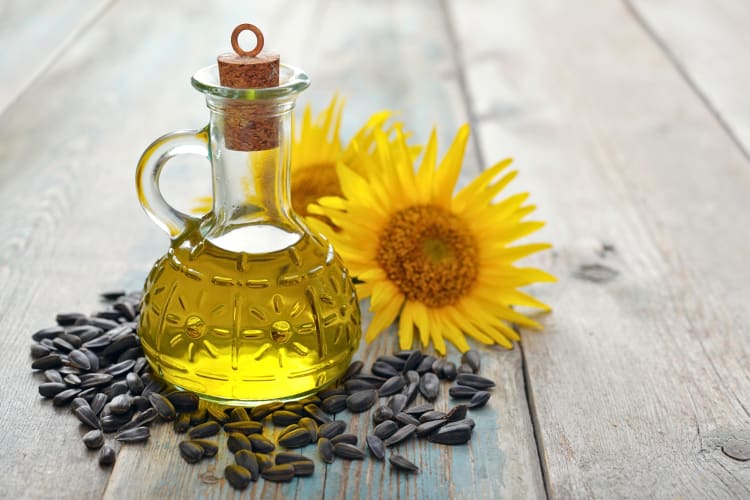
3. Avocado Oil
Few oils offer both flavor and high-heat performance like avocado oil. This pick is often listed among the healthiest cooking oils for those who want a light flavor and an oil that holds up at high temperatures. With a smoke point up to about 520 degrees Fahrenheit in refined versions, this healthy oil is one of the best oils for frying, grilling or stir-frying without turning bitter or breaking down.
What makes avocado oil one of the healthiest cooking oils is its high content of monounsaturated fats, particularly oleic acid, which is associated with improved blood lipid profiles and may help lower LDL cholesterol and support healthy blood pressure. It also provides vitamin E and small amounts of lutein depending on processing. According to the Cleveland Clinic, choosing avocado oil in place of saturated fats can be a heart-friendly option for everyday cooking.
As far as taste goes, avocado oil’s buttery flavor gives it an edge over more neutral-tasting options, to the point where it’s even used as a butter substitute for baking, sautéing and searing. The best avocado oils will add subtle richness to everything from air fryer green beans to coconut chicken.
Avocado Oil Nutritional Info (per 1-tablespoon serving)
- Calories: 120
- Total Fat: 14 grams
- Saturated Fat: 2.1 grams
- Polyunsaturated Fat: 1.9 grams
- Monounsaturated Fat: 9.9 grams
Smoke Point: 520 degrees Fahrenheit (271 degrees Celsius)

4. Olive Oil
We’ve already discussed how extra-virgin olive oil is one of the healthiest cooking oils, but its refined counterpart is also a strong choice. Rich in monounsaturated fats, particularly oleic acid, this oil has been linked with heart health and may help support a balanced inflammatory response. UC Davis Health notes that olive oil contains compounds being studied for their potential protective effects against certain harmful substances in the body.
With a moderate smoke point of about 410 degrees Fahrenheit, it holds up well under heat. Combined with its oxidative stability, this makes it one of the most healthy cooking oils to use for sautéing, roasting or baking.
Aside from being one of the healthiest cooking oils, what sets olive oil apart is how it enhances the flavor of whatever it touches. Its slightly fruity, peppery notes add depth to dishes without overpowering them. Whether you're drizzling it over Mediterranean roast vegetables, swirling it into easy pasta recipes or even using it as a mayonnaise substitute to make a light salad dressing, olive oil brings a richness that elevates a wide variety of meals.
Olive Oil Nutritional Info (per 1-tablespoon serving)
- Calories: 120
- Total Fat: 14 grams
- Saturated Fat: 2 grams
- Polyunsaturated Fat: 1.4 grams
- Monounsaturated Fat: 10 grams
Smoke Point: 410 degrees Fahrenheit (210 degrees Celsius)
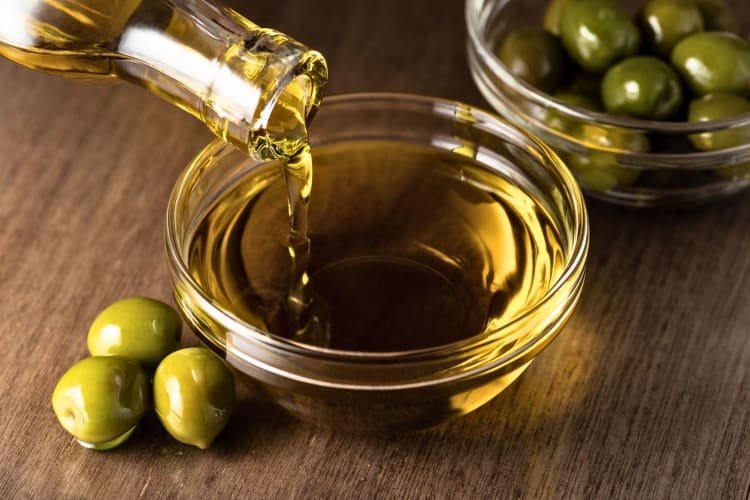
5. Sesame Oil
Sesame oil brings more than a nutty aroma to the table; it’s often included among the healthiest cooking oils for its unsaturated fat profile and natural antioxidants like sesamol and sesamin. When used instead of saturated fats, these qualities may support heart health and help the oil stay stable during cooking by reducing oxidation.
There are two variants of this healthy oil for you to try: cold-pressed and toasted. Cold-pressed sesame oil has a light, neutral flavor and a smoke point of around 410 degrees Fahrenheit. It holds up well for sautéing and stir-frying dishes, such as Korean ramen and sweet and sour shrimp. Toasted sesame oil, on the other hand, is darker and more fragrant, and is better suited for finishing dishes, such as sesame noodles, or adding depth to vinaigrettes.
While it may not be as trendy as avocado or olive oil, sesame oil remains a pantry staple across Asian and Middle Eastern cuisines. Its bold flavor and functional health perks make it a deliciously smart choice among the healthiest cooking oils for flavor-driven meals.
Sesame Oil Nutritional Info (per 1-tablespoon serving)
- Calories: 120
- Total Fat: 14 grams
- Saturated Fat: 2.1 grams
- Polyunsaturated Fat: 5.6 grams
- Monounsaturated Fat: 5.9 grams
Smoke Point: 410 degrees Fahrenheit (232 degrees Celsius)

6. Safflower Oil
Often overlooked, safflower oil quietly holds its own in the world of high-heat cooking. It ranks among the healthiest cooking oils for its unsaturated fat profile and vitamin E content, which can support healthy cholesterol levels when used in place of saturated fats, according to News-Medical.
There are two types of safflower oil to try: high-linoleic and high-oleic. The high-oleic variety of this healthy oil is the better pick for cooking, especially for deep-frying, pan-searing or roasting dishes like battered fish or mochi donuts. It also works well in batters such as lemon ricotta pancake batter.
With a smoke point of around 510 degrees Fahrenheit and a neutral taste, safflower oil is a must-try among the healthiest cooking oils for those seeking a versatile option that adds texture without overpowering flavor.
Safflower Oil Nutritional Info (per 1-tablespoon serving)
- Calories: 120
- Total Fat: 14 grams
- Saturated Fat: 1 gram
- Polyunsaturated Fat: 9.7 grams
- Monounsaturated Fat: 2.7 grams
Smoke Point: 510 degrees Fahrenheit (266 degrees Celsius)
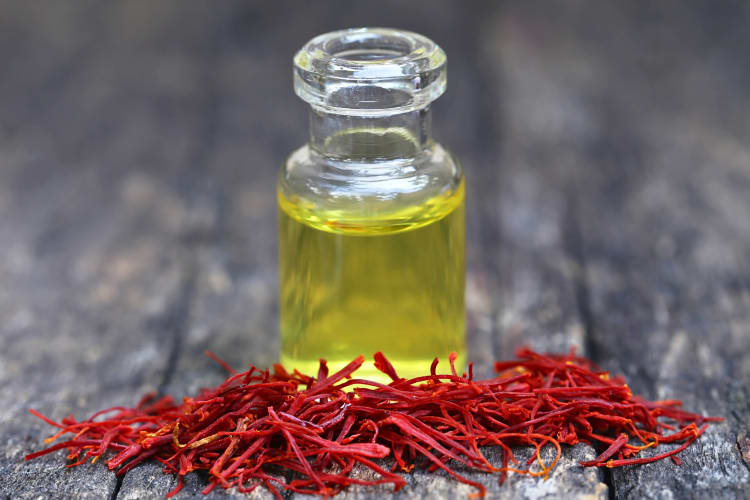
7. Peanut Oil
Peanut oil might not dominate headlines when it comes to the healthiest cooking oils, but it’s a longtime staple in restaurant kitchens and home fryers. This oil is prized for its ability to withstand high-heat techniques, such as deep frying and stir-frying, thanks to its high smoke point and balanced fat profile. From crunchy shrimp toast to juicy chicken wings, it delivers crisp results without overpowering other flavors.
The combination of monounsaturated and polyunsaturated fats places it among the healthiest cooking oils, and it provides vitamin E. For variations, refined peanut oil suits most cooking needs, while gourmet and cold-pressed versions bring a bolder, nutty flavor that works well in salad dressings.
Peanut Oil Nutritional Info (per 1-tablespoon serving)
- Calories: 120
- Total Fat: 14 grams
- Saturated Fat: 2.3 grams
- Polyunsaturated Fat: 4.3 grams
- Monounsaturated Fat: 6.2 grams
Smoke Point: 450 degrees Fahrenheit (232 degrees Celsius)

8. Canola Oil
Often overshadowed by flashier options, canola oil holds its own as one of the healthiest cooking oils and is usually more affordable than many others. It has a neutral flavor and provides vitamins E and K, along with omega-3 fat in the form of alpha-linolenic acid (ALA).
Canola oil is one of the highest common sources of ALA, second only to flaxseed oil. ALA is an essential fatty acid because the body cannot produce it, WebMD notes studies linking ALA with potential benefits for blood pressure, cholesterol and inflammation.
Of all the oils on this list, canola oil has the lowest smoke point at 400 degrees Fahrenheit, which means it isn’t one of the best cooking oils for frying. However, it shines in gentle cooking methods, such as sautéing and low-heat baking.
Whether you use it in the marinade for a tofu soup or in the batter of a fluffy banana zucchini bread, canola oil allows other ingredients to take center stage. Aside from being one of the healthiest cooking oils, it’s also fantastic when blended into dips and dressings, or even in a spread, such as granola butter.
Canola Oil Nutritional Info (per 1-tablespoon serving)
- Calories: 120
- Total Fat: 14 grams
- Saturated Fat: 1 gram
- Polyunsaturated Fat: 3.9 grams
- Monounsaturated Fat: 8.9 grams
Smoke Point: 400 degrees Fahrenheit (204 degrees Celsius)
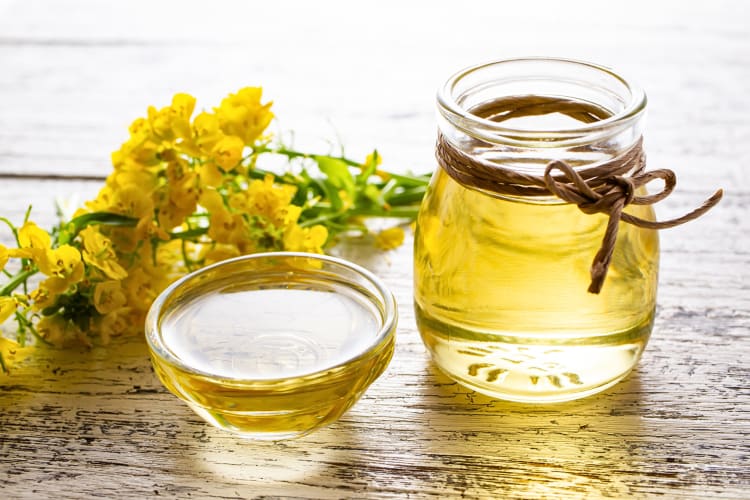
9. Rice Bran Oil
If you’re looking for one of the healthiest cooking oils that offers versatility, look to rice bran oil. Thanks to its high smoke point of about 490 degrees Fahrenheit in refined versions, it’s one of the best cooking oils for a range of culinary techniques and a wide variety of meals.
As far as health benefits go, rice bran oil contains vitamin E, antioxidants and phytosterols. MedicineNet highlights that these and other compounds have been studied for their potential to help reduce oxidative damage and may support a balanced inflammatory response. While findings continue to emerge, research is ongoing and effects can vary, so rice bran oil is best enjoyed as part of a balanced dietary pattern rather than for specific outcomes.
As you might expect, given its origin, rice bran oil has a slightly nutty yet mild flavor. It’s commonly used in Asian cuisine, forming a base for stir-fries and deep-fried meals, but it also mixes seamlessly into batters for baked goods like cakes, pastries and bread. When stored in a cool, dark and dry place, it delivers both flavor and function as one of the most unique and healthiest cooking oils.
Rice Bran Oil Nutritional Info (per 1-tablespoon serving)
- Calories: 120
- Total Fat: 14 grams
- Saturated Fat: 2.5 grams
- Polyunsaturated Fat: 4.8 grams
- Monounsaturated Fat: 6.4 grams
Smoke Point: 490 degrees Fahrenheit (254 degrees Celsius)
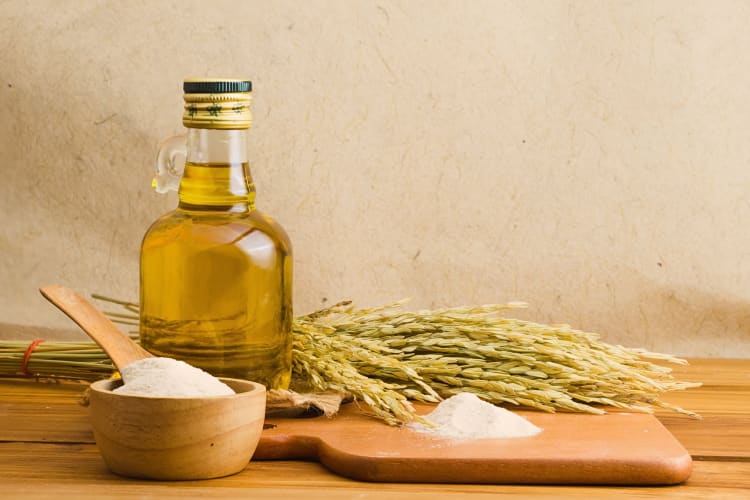
10. Macadamia Nut Oil
With about 80% monounsaturated fat, it rivals olive oil for a heart-friendly fat profile. Using oils rich in monounsaturated fat in place of saturated fat is associated with improved blood lipid profiles over time. Macadamia nut oil also has a smoke point around 425 degrees Fahrenheit, making it suitable for roasting, sautéing or pan frying.
What makes it especially unique among the healthiest cooking oils is its subtle flavor and creamy texture, which adds richness without overpowering dishes. It’s ideal for baked goods, stir-fries and seared proteins.
You’ll also find it in some of the healthiest salad dressings, combined with ingredients such as apple cider vinegar, lemon juice, and various herbs and spices. If you’re going to add it to your shopping list, it’s recommended that you store macadamia nut oil in a cool, dark place.
Macadamia Nut Oil Nutritional Info (per 1-tablespoon serving)
- Calories: 120
- Total Fat: 14 grams
- Saturated Fat: 2.1 grams
- Polyunsaturated Fat: 0.3 grams
- Monounsaturated Fat: 11.5 grams
Smoke Point: 425 degrees Fahrenheit (218 degrees Celsius)
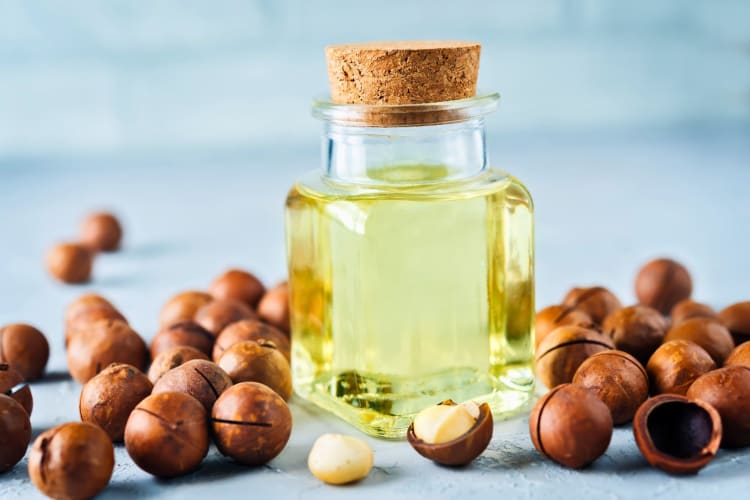
What Is the Healthiest Oil To Cook With?
When it comes to the healthiest cooking oils, extra-virgin olive oil is often considered a leading choice. It’s rich in monounsaturated fats, contains antioxidants and there is long-standing research linking regular use within a balanced diet to heart health and positive inflammatory markers.
Thanks to compounds like oleic acid and polyphenols, extra-virgin olive oil may help support healthy cholesterol levels and contribute to long-term heart health, as noted by the Cleveland Clinic. It’s also versatile, working well for sautéing vegetables, tossing into Mediterranean grain bowls or whisking into homemade vinaigrettes and Italian pasta salads.
Avocado oil also earns a spot near the top of the list of the healthiest cooking oils. With a high smoke point and a fatty acid profile similar to olive oil, it’s often used as an olive oil substitute and is ideal for higher-heat cooking, such as searing steak, roasting hassleback sweet potatoes or pan-frying chicken fajitas.
It can also be used in baking when you want a neutral flavor and added richness. Research referenced by the National Library of Medicine suggests that the healthy fats and antioxidants in avocado oil may support heart health and help protect cells from oxidative stress.
So, with all this in mind, you might still be wondering, what is the healthiest oil to cook with? It depends on how you use it, but a solid guideline is to choose minimally processed oils that are high in monounsaturated or polyunsaturated fats and use them in moderation as part of a balanced diet.
The healthiest cooking oils are context dependent and should match your cooking method, taste, culture and nutrition needs. If you’re a beginner in the kitchen or you’re still confused about the best oils to cook food with, the following guidelines will help you:
Healthiest Oils for Baking, Oven Cooking and Stir-Frying
- Avocado Oil
- Safflower Oil
- Rice Bran Oil
- High-Oleic Sunflower Oil
Healthiest Oils for Sautéing and Low-Heat Baking
- Extra-Virgin Olive Oil
- Olive Oil
- Macadamia Nut Oil
- Canola Oil
Healthiest Oils for Searing and Browning
- Avocado Oil
- Safflower Oil
- Rice Bran Oil
- Peanut Oil
Healthiest Oils for Dressings and Marinades
- Extra-Virgin Olive Oil
- Macadamia Nut Oil
- Avocado Oil
- Sesame Oil

Which Cooking Oil Is the Unhealthiest?
With so much focus on the healthiest cooking oils, such as olive, avocado and canola, you may also wonder which oils are less ideal for regular use. There isn’t one single “worst” oil, but partially hydrogenated vegetable oils, also known as trans fats, are widely considered the least healthy.
These chemically altered oils stay solid at room temperature, which increases shelf life but is linked to negative effects on heart health. As noted by the Mayo Clinic, trans fats raise LDL cholesterol, lower HDL cholesterol and increase the risk of heart disease and stroke.
While they’ve been largely removed from the U.S. food supply, small amounts can still appear in processed foods. Checking labels can help you keep them out of your kitchen when choosing the healthiest cooking oils.
Beyond trans fats, there are a few other cooking fats that may not be ideal for everyday use:
Butter and Margarine
Butter and some margarines are less favorable choices for long-term heart health when used frequently, mainly due to their saturated fat content and, in some older formulations, trans fats. In a large-scale study of over 521,000 adults published in BMC Medicine, both were associated with higher mortality from heart disease and diabetes. Choosing from the healthiest cooking oils more often can support a heart-friendly eating pattern.
Coconut Oil

How We Choose the Healthiest Cooking Oils
Thanks to market saturation, deciding which oils fall into the category of the healthiest cooking oils can be a tricky task. Luckily, we’ve considered all the options and consolidated the information for you.
With more than a decade of experience in the culinary field, we not only understand the needs of health-conscious people but also have the necessary expertise to create informative guides like this one.
To ensure the information we present is factual and thorough, our editorial team undergoes an extensive research process. This involves reviewing information from health professionals, such as nutritionists, as well as the chefs we connect people with on a daily basis.
Additionally, our guide on the healthiest cooking oils is based on the following criteria:
- Fat Profile: Oils that are lower in saturated fat and free of trans fat, and provide mostly monounsaturated or polyunsaturated fats, are generally considered among the healthiest cooking oils.
- Nutritional Value: Beyond their fat composition, some of the healthiest cooking oils offer added nutrients, such as vitamin E, antioxidants and essential fatty acids, which can contribute to overall health.
- Cooking Performance: We considered smoke point and overall stability when heated, as these factors affect how well an oil holds up during different cooking methods.
- Processing Method: Oils that are minimally processed or cold-pressed were given preference, as they tend to retain more of their natural flavor and beneficial compounds.
Registered Nutritionist Review
As with all our guides, we want to ensure that this one is factually accurate and as helpful as possible. To do that, we enlisted the help of Jessica O'Shea, a Registered Nutritionist (ANutr) with the Association for Nutrition.
Thanks to a BSc (Hons) in Food, Nutrition and Wellbeing, as well as an MSc in Human Nutrition, Jessic has the necessary expertise required to review all healthy foods, including the healthiest cooking oils. With a passion for helping people that aligns with our desire for everyone to make more informed dietary choices, her assistance proved invaluable in helping us create a thorough guide that’s easily accessible.
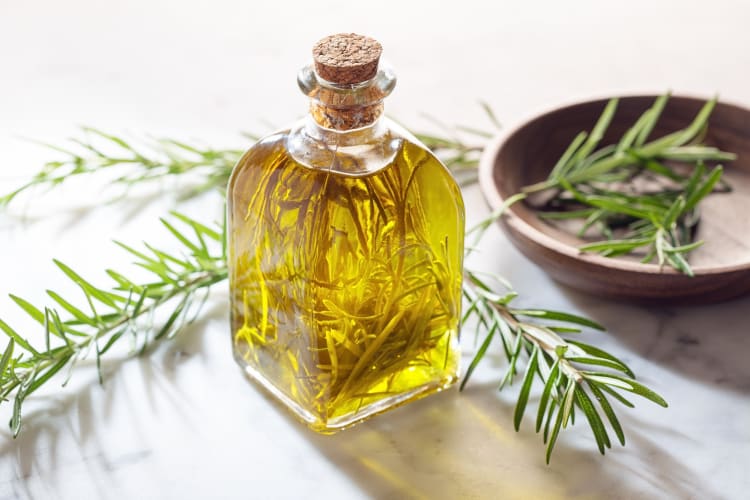
Learn To Cook Healthy Food
Taking a cooking lesson can completely change the way you eat at home, especially if you’re curious about how to use the healthiest cooking oils. Whether you sign up for an in-person cooking class near you or follow along with healthy online cooking classes, learning from skilled instructors makes it easier to build confidence in the kitchen and pick up techniques that support your well-being.
Many classes focus on how to prepare meals using the healthiest cooking oils, such as extra-virgin olive oil or avocado oil. You’ll learn when and how to use each one based on various dishes and cooking methods. You’ll also gain a better sense of which oil fits your lifestyle based on your taste preferences and nutritional needs.

Choosing the healthiest cooking oils doesn’t mean giving up the flavors you love. With the right oil, you can enjoy favorite dishes while supporting a balanced eating pattern.
Now that you’ve got a list of the healthiest cooking oils, you can make swaps based on how you cook and what you like to eat. It’s about matching the oil to your kitchen style and nutrition goals so meals taste great and fit your needs.
For even more ways to explore your favorite foods, check out other experiences happening on Cozymeal.



FOOD FOR THOUGHT?
Join the conversation.